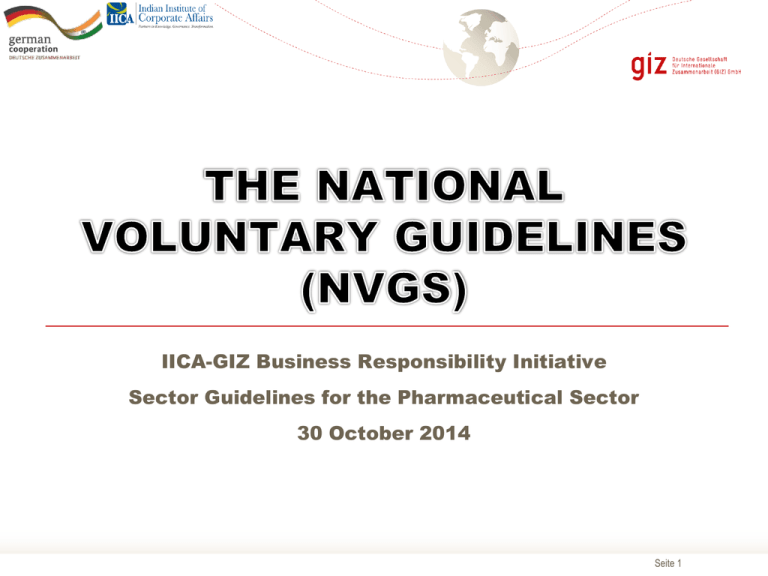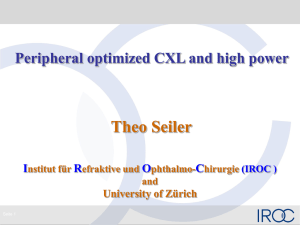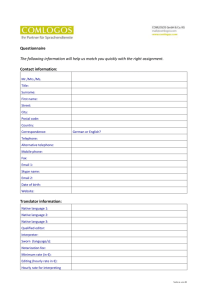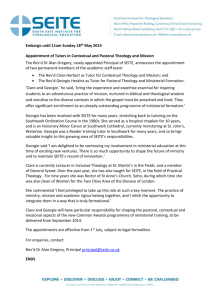THE NATIONAL VOLUNTARY GUIDELINES (NVGS)
advertisement

IICA-GIZ Business Responsibility Initiative Sector Guidelines for the Pharmaceutical Sector 30 October 2014 Seite 1 Pharma sector trends| Reputational risks •. At present the Indian pharmaceutical industry has about 300 large units, 1700 medium-size units and about 8000 small-scale units throughout the country. •India currently exports drug intermediates, Active Pharmaceutical Ingredients (APIs), Finished Dosage Formulations (FDFs), Bio-Pharmaceuticals, Clinical Services to various parts of the world. The export industry stands at USD 9.1 billion. •The domestic Pharma Industry has recently achieved some historic milestones through a leadership position and global presence as a world class cost effective generic drugs' manufacturer of AIDS medicines •India’s position as a strong player in the global pharmaceutical market had been under attack for some time with the notion that Indian drug makers also produce and export spurious drugs. •The Centre has decided to conduct an all India survey on the extent of availability of spurious and not-of-standard quality drugs in the country. It is expected to be a broadbased survey covering 42,000 samples belonging to 15 therapeutic groups. Seite 2 Pharma sector trends| Policy •Highly regulated sector: various policies, laws, institutions •Policy/law set at national level and implemented by state •Detailed yet complicated regulatory framework (N & S legislation/institutions) • Stringent GMP enforcement (Schedule M, D&C Act 1940) •Strict government price regulation (DPCO, 2013) •The implementation of the TRIPS Agreement will give rise to factors that can put access to medicines out of reach for millions of people in the developing world. •To truly improve access to medicines in India, we will need to continue to work together to advance sustainable policy solutions to healthcare financing, infrastructure, and human resources challenges, among others, rather than focus on compulsory licences or other ways of undermining patent protection of innovative medicines. Seite 3 Trends in BR reporting in the sector In a study conducted by PWC and commissioned by the IICA-GIZ Business Responsibility Initiative, the first set of BRRs of the top 100 listed companies were analysed, out of which 5 are pharmaceutical companies. Very limited reportage of details of resource use reduction by way of raw material recovery processes and reduction in packaging and printing No reportage of safe usage and side-effects of medicines and drugs Labelling practices focusing on mandates only Percentage of inputs sourced sustainably not reported Quantitative figures on waste management/recycling not reported Litigation challenges not addressed Seite 4 5 BACKGROUND AN INTRODUCTION TO THE NVGs National Voluntary Guidelines – the relevance to your Seite 5 Definitional Clarity Triple bottomline Business Responsibility An allencompassing framework Responsible Business Economy Sustainability ESG Seite 6 NVGs: BACKGROUND International and Indian perspective on social responsibility Different practices/ prescriptions by different agencies Need for a holistic Indian concept of Business Responsibility: Social responsibilities Environmental responsibilities Economic responsibilities Seite 7 Essence of the NVGs Competitiveness-responsibility-development go together Focus on Materiality Focus on integration Stakeholder engagement Value creation Reporting Seite 8 Consultations and Consensus 09 consultations (government, Civil society, FIs, MSMEs, large businesses) Written feedback (national and international) 2000 comments (editorial, substantive, technical, adoption models) Clear and transparent criteria for feedback incorporation Seite 9 NVGs: Structure 9 Principles with brief description and 48 core elements Implementation Guidance Indicators ( metrics) to enable self-monitoring Specific inputs for MSMEs Case-lets to aid comprehension of good practices Business case matrix Mapping of Principles against prevailing laws and Acts Glossary of terms used Seite 10 NVGs: The nine principles P R I N C I P L E S 1. • Transparency, ethics and accountability 2. • Providing goods and services that are sustainable over entire life cycle 3. • Well-being of employees 4. • Being responsive towards stakeholders, especially the disadvantaged 5. • Respecting and promoting human rights 6. • Protecting and restoring the environment 7. • Responsible policy advocacy that enhances public good 8. • Supporting inclusive growth and development 9. • Providing value to customers responsibly Indivisibility of principles key to linking competitiveness, responsibility and development Seite 11 impact. Implementation guidance Four pillars of Implementation Components of Implementation Guidance Approach to adoption of Guidelines Leadership Integration Building a Responsible Business Strategy Engagement Reporting Indicators for selfassessment Seite 12 Implementation guidance Steps Commitment of Top Management and supportive governance structure Analysis and Improvement Continuous improvement Policy Deployment and Process management Monitoring and Evaluation Disclosure and reporting Sensitization and Training Stakeholder Engagement Seite 13 Disclosure Framework A framework for reporting on performances related to the Guidelines Envisioned to be an enabling instrument “Apply or Explain” Pragmatic, light and single format Accountability and aggregation of data – public good Business case – what you can measure, you can manage – improves performance of companies Seite 14 Objective of BRR It is about the process, meaningful disclosure • Organizational overview • Strategy • Performance • Opportunities and risks • Future outlook Seite 15 Report and Reporting Reporting Report Reporting is: Reporting is not: • A process of • An event with a identifying issues that starting and ending affect and are affected time by a business • A data generating • A continuous, ongoing activity activity 16 Seite 16 17 Seite 17 Rationale for Sector Guidelines Specific and most relevant sector issues under each principle are brought forth Aid better implementation and reporting by companies on sustainability issues Aid comparability with peers, provide sector wide data Seite 18 Implementation Guidance • The nine principles remain • The core elements change to become specific to the sector • Material issues relevant to different segments of the pharma sector reflected in core elements • Guidance document on how to integrate the guidelines into the company’s core operations • (a) Policy design/ roadmap • (b) Selfassessment Indicators (core/advanced) 3. Principles and Core elements 2. 1. Key Components of proposed structure of the guidelines Disclosure or Non-financial reporting framework • To help the pharma company: • Focus on materiality • Encourage them to ‘Apply or Explain’ • Review organisational strategy • Create value Seite 19 Thank you Neha Kumar, GIZ Seite 20











